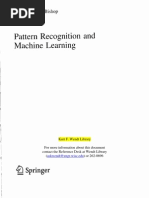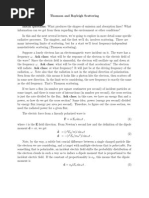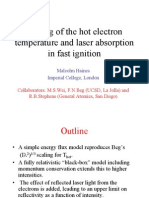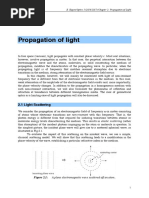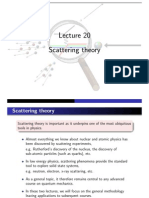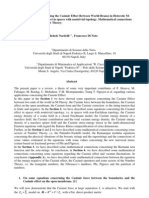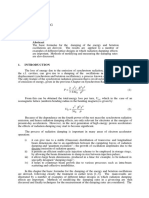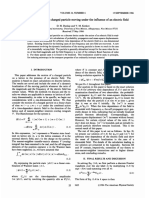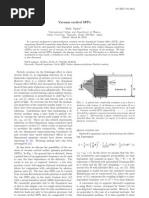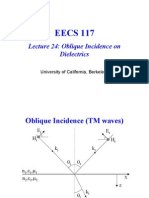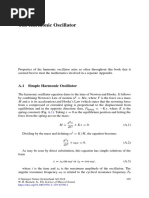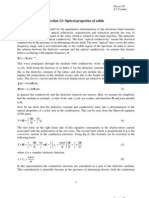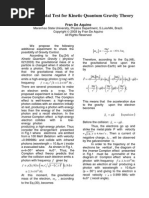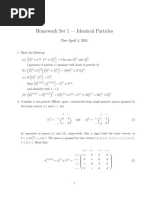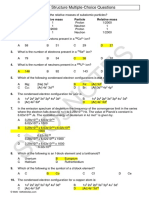Module III: Relativistic ED: Applications: Lectures 14-15: EM Radiation Passing Through Matter
Module III: Relativistic ED: Applications: Lectures 14-15: EM Radiation Passing Through Matter
Uploaded by
microdotcdmCopyright:
Available Formats
Module III: Relativistic ED: Applications: Lectures 14-15: EM Radiation Passing Through Matter
Module III: Relativistic ED: Applications: Lectures 14-15: EM Radiation Passing Through Matter
Uploaded by
microdotcdmOriginal Description:
Original Title
Copyright
Available Formats
Share this document
Did you find this document useful?
Is this content inappropriate?
Copyright:
Available Formats
Module III: Relativistic ED: Applications: Lectures 14-15: EM Radiation Passing Through Matter
Module III: Relativistic ED: Applications: Lectures 14-15: EM Radiation Passing Through Matter
Uploaded by
microdotcdmCopyright:
Available Formats
Module III: Relativistic ED: applications
Lectures 14-15: EM radiation passing through matter
Amol Dighe
TIFR, Mumbai
Outline
Interactions of EM elds with electrons
Scattering of EM wave by a free electron
Scattering of an EM wave by a bound electron
Absorption by a bound electron
Refractive index: collective scattering by electrons
Outline
Interactions of EM elds with electrons
Scattering of EM wave by a free electron
Scattering of an EM wave by a bound electron
Absorption by a bound electron
Refractive index: collective scattering by electrons
Electron in a harmonic potential
When an EM wave passes through matter, its propagation may
be understood at the microscopic level by looking at its
interactions with the electrons in the material.
A simple model that helps in understanding many phenomena is
that of electrons in a harmonic potential that are acted upon by
the EM eld and the radiation reaction force.
This model will help us understand Thomson scattering,
resonant scattering of light, Rayleigh scattering, absorption and
refractive index of materials.
The harmonic force
F = k
x = m
2
0
x, provided by the binding
of the electrons with the atoms, is the dominant force and gives
rise to the leading order equation of motion
m
a = m
2
0
x . (1)
The braking force
The leading order EoM gives rise to d
a/dt =
2
0
v, leading to
the radiation reaction force
f
rad
=
e
2
6
0
c
3
d
a
dt
=
e
2
2
0
6
0
c
3
v = m
v , (2)
where = (e
2
2
0
)/(6
0
mc
3
).
The equation of motion, in the absence of any external EM eld,
is then
x +
x +
2
0
x = 0 . (3)
The
x term is like a general braking/friction term, which may
have origins other than the radiation reaction force. The origin of
does not matter for the rest of our analysis in this lecture.
For small , the solution to this equation is
x =
x
0
exp
_
i
0
t
t
2
_
. (4)
The external EM eld
Let the external EM eld be a linearly polarized one, with the
electric eld component
E
ext
= E
0
z exp[i (kx t )].
If the motion of the electron (equilibrium position
x =
0) is limited
to a small region (|
x| , or k|
x| 1), the force on this electron
will be
F
ext
= eE
0
z exp(i t ).
The magnetic component of the EM eld will also contribute to
the Lorentz force on the charge. However, this force is
suppressed by a factor v/c compared to e
E
0
, where v is the
typical speed of the electron. Since v/c 1 for electrons inside
normal materials, we can neglect this component of the force.
The equation of motion for the electron is then
x +
x +
2
0
x =
e
m
E
0
z exp(i t ) . (5)
Solution for EoM of the electron (1D motion)
Let us restrict ourselves to a one-dimensional situation, where
the motion of the electron is in the same direction as the
polarization of
E
ext
, i.e. the z-axis.
Looking for solutions of the form z = z
e
i t
, we get
2
z i z +
2
z =
e
m
E
0
. (6)
The solution is
z
=
e
m
E
0
1
(
2
2
0
) + i
. (7)
We shall now see how this simple model can explain many
situations.
Outline
Interactions of EM elds with electrons
Scattering of EM wave by a free electron
Scattering of an EM wave by a bound electron
Absorption by a bound electron
Refractive index: collective scattering by electrons
Radiation due to the acceleration of free electron
For a free electron, there is no harmonic restoring force, so that
0
= 0. Let us neglect the radiation reaction force, i.e. well work
in the limit 0.
In this situation,
z
=
e
m
E
0
1
2
; , a
=
z
=
e
m
E
0
. (8)
Thus, a
is independent of , the frequency of incident radiation.
This acceleration leads to the radiation eld
E
rad
=
e
4
0
c
2
r
3
[
r (
a)] . (9)
Note that we are in the non-relativistic limit.
The magnitude of this electric eld is
|
E
rad
| =
ea sin
4
0
c
2
r
(10)
where is the angle made by
r with the z axis, which is the
direction of acceleration.
Intensity of radiation
The magnitude of the Poynting vector, which represents the
intensity of radiation, is then
I
rad
= |
N
rad
| =
1
2
_
0
|
E
rad
|
2
=
1
2
_
0
_
eE
0
4
0
mc
2
_
2
sin
2
r
2
. (11)
where we have used the relation between the acceleration and
incident electric eld
E
ext
.
In terms of the intensity of the incident radiation
I
0
=
1
2
_
0
E
2
0
, (12)
this may be written as
I
rad
= I
0
sin
2
r
2
e
r
2
, (13)
where r
e
e
2
/(4
0
mc
2
) is the classical radius of the electron.
Radiated power and Thomson cross section
The total rate of radiative energy loss is
dU
dt
=
_
I
rad
r
2
d =
_
I
0
sin
2
r
2
e
r
2
,
=
8
3
r
2
e
I
0
(14)
This may be interpreted as the scattering of the incident
radiation by the electron, resulting in the loss of the incident
power by radiation. The scattering cross section is then
0
=
dU/dt
I
0
=
8
3
r
2
e
(15)
This is the Thomson scattering cross section.
Note that the Thomson cross section is more than the naive
surface area of the classical electron, r
2
e
.
Outline
Interactions of EM elds with electrons
Scattering of EM wave by a free electron
Scattering of an EM wave by a bound electron
Absorption by a bound electron
Refractive index: collective scattering by electrons
Cross section for scattering off a bound electron
For a bound electron,
z
=
e
m
E
0
1
(
2
2
0
) + i
, a
=
z
=
e
m
E
0
2
(
2
2
0
) + i
.
(16)
Note that now the acceleration depends on , the frequency of
incident radiation.
Then the magnitude of the radiated electric eld is
|
E
rad
| =
qa sin
4
0
c
2
r
=
q
4
0
mc
2
2
E
0
_
(
2
2
0
)
2
+ ()
2
sin
r
(17)
This leads to the scattering cross section
scat
=
0
4
(
2
2
0
)
2
+ ()
2
. (18)
where
0
is the Thomson cross section.
Resonant scattering
The scattering cross section
scat
as a function of becomes
large at =
0
. This is the resonance condition.
At resonance, the cross section is
res
=
0
2
0
2
. (19)
For
0
, this could be a large enhancement. The cross
section at this frequency can be much larger than the classical
electron area.
Strong binding limit: Rayleigh scattering
When the restoring harmonic force is much stroner compared to
the energy of the incident radiation, i.e.
0
, one gets
large
0
=
0
4
0
, (20)
where we have also assumed
2
0
.
Thus in the strong binding limit, the scattering cross section
increases as the fourth power of the incident frequency. This is
Rayleigh scattering.
Rayleigh scattering implies that the blue colour in the sunlight is
scattered much more than the red colour in the atmosphere, and
hence the sky looks predominantly blue as long as we are not
looking at the sun directly.
Outline
Interactions of EM elds with electrons
Scattering of EM wave by a free electron
Scattering of an EM wave by a bound electron
Absorption by a bound electron
Refractive index: collective scattering by electrons
Work done by the EM eld on an electron: 1D
The EM wave imparts energy to the electron by doing work on it,
which can be computed as
U = Re
__
+
E
ext
(t )
x(t ) dt
_
= Re
__
+
eE
0
(t )
z(t ) dt
_
,
(21)
where the electric eld as well as the motion of the electron is
along z direction.
For calculating U, we shall use the Fourier transform identity
_
+
p(t )q(t )dt = 2
_
+
0
p
d , (22)
For this, we need to use the Fourier-transformed quantities E
and
= i z
=
e
m
E
0
i
(
2
2
0
) + i
. (23)
Energy absorbed by an electron
The total energy absorbed is
U = 2
e
2
m
Re
__
+
E
2
i
(
2
2
0
) + i
d
_
= 2
e
2
m
_
+
0
E
2
2
2
(
2
2
0
)
2
+
2
2
d (24)
The factor 2 in the integrand comes from the change in the
limits of integration.
For small , the resonance term is sharply peaked and we may
approximate
U = 2
e
2
m
E
2
0
2
2
0
_
+
0
1
(
2
2
0
)
2
+
2
2
d
=
2e
2
m
E
2
0
2
2
0
2
2
0
=
2
2
e
2
m
E
2
0
(25)
Thus, the total energy absorbed is independent of
(in the small- limit).
Incident energy ux
The total incident energy ux per unit area is
S =
_
+
N(t )dt =
_
0
_
+
E
2
0
dt =
0
c
_
+
E
2
0
dt . (26)
In terms of the Fourier-transformed quantities,
S = 2
0
c
_
+
E
2
d . (27)
The incident energy ux at a frequency is
S
= 4
0
cE
2
(28)
where the factor of 2 comes from the fact that the contribution is
from both, .
Absorption cross section
One may dene the absorption cross section at frequency as
the ratio of total energy absorbed at that frequency to the energy
ux per unit area at that frequency.
The energy absorbed at frequency is
U
= 2
e
2
m
E
2
2
2
(
2
2
0
)
2
+
2
2
, (29)
which is just the integrand in the expression for U.
Then one gets the absorption cross section as
abs
() =
U
= 2
e
2
m
2
2
(
2
2
0
)
2
+
2
2
1
4
0
c
. (30)
Absorption cross section at resonance
For small , the absorption takes place only at frequencies close
to the resonance frequencies. The incident energy ux at this
frequency is S
0
= 4
0
cE
2
0
.
The cross section at this energy is
abs
(
0
) =
U
0
S
0
=
4e
2
m
1
4
0
c
=
4r
e
c
. (31)
Note that the resonant cross section is independent of the actual
value of
0
.
Outline
Interactions of EM elds with electrons
Scattering of EM wave by a free electron
Scattering of an EM wave by a bound electron
Absorption by a bound electron
Refractive index: collective scattering by electrons
Polarization due to an incident EM wave
At a microscopic level, the refracive index may be viewed as
arising from the polarization of the material, which itself is
caused by the action of the incident EM eld on the electrons.
In the absence of the external EM eld, the material is
unpolarized, that is the positive and negative charge densities
cancel each other out everywhere inside the material.
When the EM eld is incident on the material, the electrons (free
electrons, valence electrons, or electrons which are loosely
bound), being lighter, move under its inuence. The movement
of the rest of the ions may be neglected.
If the displacement of an individual electron from its mean
position is
x, and the number density of such electrons is N, the
collective polarization is
P = N e
x . (32)
Wave equation in the presence of polarization
In the presence of polarization
P, the Maxwells equation that
gets modied is
B =
0
_
E
t
+
P
t
_
(33)
This, combined with
E =
B/t yields
(
E) =
t
(
B)
i.e. (
E)
2
E =
_
E
t
2
+
0
P
t
2
_
(34)
Since the net charge density inside the dielectric is zero,
E = 0 and we get
E
1
c
2
E
t
2
0
P
t
2
= 0 . (35)
Refractive index
With the direction of motion of the electrons and the polarization
of the incident
E eld along z direction,
P = N e z
z =
Ne
2
E
m
1
(
2
0
2
) i
z . (36)
Thus our situation is that of a linear dielectric, with the
polarizability
P
0
E
=
Ne
2
m
1
2
0
2
i
. (37)
With
P =
0
E, the wave equation becomes
E
(1 +)
c
2
E
t
2
= 0 . (38)
The speed of propagation of this wave is c/
1 +, and hence
the refractive index is
n =
_
1 + . (39)
Complex refractive index of a dilute electron gas
Our analysis is valid for dilute electron gases, since we have
assumed that the local eld
E is the same as the incoming eld
E
ext
. In such case, we get
n
2
= 1 + = 1 +
Ne
2
m
1
2
0
2
i
. (40)
It is assumed that all the electrons have the same binding
frequency
0
.
If there are more than one set of electrons with different binding
frequencies, the linearity of the problem allows us to just add the
contributions to .
The refractive index n is in general a complex number, implying
absorption. A nonzero value of is one source of such
absorption.
Behaviour of the refractive index
At low incident frequencies ( <
0
):
As long as
0
, the refractive index is almost real, and
greater than unity. Also, when increases, the refractive index n
aso increases. This is the same as the behaviour of light rays
through prism.
Around
0
:
The refractive index has a signicant imaginary component, and
the dilute gas acts as an absorber.
At large frequencies ( >
0
):
The refractive index is less than 1. Note that this does not lead to
faster-than-c propagation. (See Problem on the following page.)
At extremely large frequencies (
2
Ne
2
/(m
0
)):
The refractive index n 1. (We referred to this while discussing
Cherenkov radiation.)
Dilute gas of free electrons
Problem
Using the expression for the refractive index of a dilute electron
gas with number density N, plot the phase velocity and group
velocity of an EM wave as a function of . Neglect the damp-
ing term and choose an appropriate value for N. Where is the
dilute nature of the gas relevant ?
Problem
Show that a dilute gas of free electrons will not allow an EM
wave to propagate through it, if the frequency of the wave is less
than a cutoff frequency
cutoff
. Determine the cutoff frequency
in terms of the number density of electrons and other universal
constants. For >
cutoff
, qualitatively plot the behaviour of the
wavenumber k as a function of .
Take-home message from this lecture
A simple model of electrons bound to the nucleus with a
harmonic potential can help model the scattering and absosption
of an EM wave
The cross sections of Thomson scattering, resonance
scattering, Rayleigh scattering and resonant absorption follow
naturally in this model.
Essential properties of the refractive index of a dilute electron
gas can also be calculated, and its frequency behaviour studied.
You might also like
- Electricity and Magnetism II - Jackson Homework 3Document4 pagesElectricity and Magnetism II - Jackson Homework 3Alejandro Espinosa100% (1)
- 3 Free Electron Theory of Metals: 3.1 Drude ModelDocument12 pages3 Free Electron Theory of Metals: 3.1 Drude Modeljustinl1375535No ratings yet
- Pattern Recognition and Machine LearningDocument11 pagesPattern Recognition and Machine Learningmicrodotcdm29% (7)
- Achiever'S Comprehensive Course (Faqs)Document9 pagesAchiever'S Comprehensive Course (Faqs)microdotcdmNo ratings yet
- PDF Durst Laborator 1200 Manual EngDocument135 pagesPDF Durst Laborator 1200 Manual Eng零点先生Zero100% (1)
- E111 - AgustinDocument20 pagesE111 - AgustinSeth Jarl G. AgustinNo ratings yet
- 604 BookDocument82 pages604 BooknewzadNo ratings yet
- Thomson and Rayleigh ScatteringDocument5 pagesThomson and Rayleigh ScatteringpankajNo ratings yet
- Classical Electromagnetism and OpticsDocument159 pagesClassical Electromagnetism and OpticsRodrigo PaludoNo ratings yet
- A System To Convert Gravitational Energy Directly Into Electrical EnergyDocument17 pagesA System To Convert Gravitational Energy Directly Into Electrical EnergyFran De AquinoNo ratings yet
- EM Waves in Material Media: 1 Wave PropagationDocument8 pagesEM Waves in Material Media: 1 Wave PropagationDinesh RamuNo ratings yet
- Making Sense of The Equation Sheet Interference & DiffractionDocument6 pagesMaking Sense of The Equation Sheet Interference & DiffractionAkash KapoorNo ratings yet
- 4-Optical Properties of Materials-Dielectrics and MetalsDocument36 pages4-Optical Properties of Materials-Dielectrics and MetalsvenkateshsanthiNo ratings yet
- Scaling of The Hot Electron Temperature and Laser Absorption in Fast IgnitionDocument20 pagesScaling of The Hot Electron Temperature and Laser Absorption in Fast IgnitionKevin M GeorgeNo ratings yet
- Static Magnetic Field Influence On Ponderomotive Self Focusing of Laser Beam Through PlasmaDocument12 pagesStatic Magnetic Field Influence On Ponderomotive Self Focusing of Laser Beam Through PlasmaImpact JournalsNo ratings yet
- Electron-Phonon Interaction: 2.1 Phonons and Lattice DynamicsDocument14 pagesElectron-Phonon Interaction: 2.1 Phonons and Lattice DynamicsYeong Gyu KimNo ratings yet
- Lorentz Dispersion ModelDocument5 pagesLorentz Dispersion ModelHenry FernandezNo ratings yet
- Optics I 2017 Chapter2 PDFDocument44 pagesOptics I 2017 Chapter2 PDFAnas BachiriNo ratings yet
- Chapter 1Document17 pagesChapter 1Grant HeilemanNo ratings yet
- Excitons in Bulk and Low-Dimensional SemiconductorsDocument9 pagesExcitons in Bulk and Low-Dimensional Semiconductorsprakush_prakushNo ratings yet
- Atomic Physics3Document13 pagesAtomic Physics3Rashid AliNo ratings yet
- 2.57 Nano-to-Macro Transport Processes Fall 2004: Ae Be CeDocument7 pages2.57 Nano-to-Macro Transport Processes Fall 2004: Ae Be CecaptainhassNo ratings yet
- Exercise2 SolutionDocument8 pagesExercise2 SolutionmohamedNo ratings yet
- Compton ScatteringDocument6 pagesCompton Scatteringffr.gimenezNo ratings yet
- Radiation PressureDocument19 pagesRadiation PressurebhishanNo ratings yet
- P2214 Homework 14 Solutions - Spring 2011Document7 pagesP2214 Homework 14 Solutions - Spring 2011calcyeeNo ratings yet
- Lec20-21 - Compressed SCATTER PDFDocument54 pagesLec20-21 - Compressed SCATTER PDFBobby WardNo ratings yet
- Interaction of RadiationDocument54 pagesInteraction of RadiationWayel AmanNo ratings yet
- Unit - V Electromagnetic WavesDocument30 pagesUnit - V Electromagnetic WavesArul RajNo ratings yet
- ExcitonsDocument44 pagesExcitonsFei PuNo ratings yet
- The Relationship Between Loss, Conductivity and Dielectric ConstantDocument12 pagesThe Relationship Between Loss, Conductivity and Dielectric ConstantMagelicanNo ratings yet
- Lecture 2Document55 pagesLecture 2Zahid SaleemNo ratings yet
- 2.57 Nano-to-Macro Transport Processes Fall 2004Document9 pages2.57 Nano-to-Macro Transport Processes Fall 2004captainhassNo ratings yet
- Determination of Wave Length of Laser Radiation by Interference. Jung MethodDocument12 pagesDetermination of Wave Length of Laser Radiation by Interference. Jung MethodMəhəmmədəliNo ratings yet
- Lecture 11Document19 pagesLecture 11JayeshAtreyaNo ratings yet
- Waves in Media: Ashcroft and Mermin, Solid State Physics (Saunders College, 1976, Page 553)Document42 pagesWaves in Media: Ashcroft and Mermin, Solid State Physics (Saunders College, 1976, Page 553)Amina lbrahimNo ratings yet
- Zero Point EnergyDocument55 pagesZero Point EnergyFernando Martinez LeyvaNo ratings yet
- Physics Paper Set 1Document20 pagesPhysics Paper Set 1tsubham2022No ratings yet
- On some equations concerning the Casimir Effect Between World-Branes in Heterotic M-Theory and the Casimir effect in spaces with nontrivial topology. Mathematical connections with some sectors of Number Theory.Document59 pagesOn some equations concerning the Casimir Effect Between World-Branes in Heterotic M-Theory and the Casimir effect in spaces with nontrivial topology. Mathematical connections with some sectors of Number Theory.Michele NardelliNo ratings yet
- Quantum Mechanics II - Homework Assignment 5: Alejandro G Omez Espinosa March 23, 2013Document5 pagesQuantum Mechanics II - Homework Assignment 5: Alejandro G Omez Espinosa March 23, 2013Alejandro EspinosaNo ratings yet
- p461 PDFDocument20 pagesp461 PDFHemant SinghNo ratings yet
- Radiation Damping: R.P. WalkerDocument20 pagesRadiation Damping: R.P. WalkerKhurram KirmaniNo ratings yet
- Lecture-X: Small OscillationDocument15 pagesLecture-X: Small OscillationPedro Ibarbo PerlazaNo ratings yet
- Inducing A Magnetic Monopole With Topological Surface StatesDocument9 pagesInducing A Magnetic Monopole With Topological Surface StatesMike WestfallNo ratings yet
- Free Electron Fermi Gas (FEFG) : Phys 175A Dr. Ray Kwok SjsuDocument38 pagesFree Electron Fermi Gas (FEFG) : Phys 175A Dr. Ray Kwok SjsuGetachew YirgaNo ratings yet
- 0.1 Conservation of Momentum and The Maxwell Stress TensorDocument8 pages0.1 Conservation of Momentum and The Maxwell Stress TensorBen RobertsNo ratings yet
- Of Of: Particle The ElectricDocument12 pagesOf Of: Particle The ElectricAnderson BuarqueNo ratings yet
- Electromagnetic Waves in Plasma PhysicsDocument18 pagesElectromagnetic Waves in Plasma PhysicsSaidAbdullah360No ratings yet
- 1 Interference of Two Optical FieldsDocument4 pages1 Interference of Two Optical FieldsprakhargodaraNo ratings yet
- CHAPTER 10: Atomic Structure and Atomic SpectraDocument25 pagesCHAPTER 10: Atomic Structure and Atomic SpectraVijay PradhanNo ratings yet
- Forces Entre La Llum I La MateriaDocument6 pagesForces Entre La Llum I La MateriaPau Castilla GonzálezNo ratings yet
- Widths and Profiles of Spectral LinesDocument2 pagesWidths and Profiles of Spectral LinesZain Shah Zain ShahNo ratings yet
- RP2.1 Lesson-7Document14 pagesRP2.1 Lesson-7Taushiful HoqueNo ratings yet
- VACUUM SPPsDocument4 pagesVACUUM SPPswade.naylorNo ratings yet
- Lecture 24 Oblique Incidence On DielectricsDocument19 pagesLecture 24 Oblique Incidence On Dielectricsvaldesc_tolNo ratings yet
- Maxwell's Equations and Light WavesDocument24 pagesMaxwell's Equations and Light WavesFarizalNo ratings yet
- Análisis de Fourier de La EnergíaDocument107 pagesAnálisis de Fourier de La EnergíaElvyn OjedaNo ratings yet
- Section 13 Optical Properties of SolidsDocument9 pagesSection 13 Optical Properties of SolidsFatma AbdallahNo ratings yet
- ZeemanDocument26 pagesZeemanYash ShahNo ratings yet
- Kin Ect I Ccu An Tum Gravity TheoryDocument11 pagesKin Ect I Ccu An Tum Gravity TheoryLuis Alberto MiglioreroNo ratings yet
- SECTION-BDocument3 pagesSECTION-Bleo.nardo98354No ratings yet
- Feynman Lectures Simplified 2C: Electromagnetism: in Relativity & in Dense MatterFrom EverandFeynman Lectures Simplified 2C: Electromagnetism: in Relativity & in Dense MatterNo ratings yet
- Intensity of Electromagnetic Waves as a Function of Frequency, Source Distance and Aperture AngleFrom EverandIntensity of Electromagnetic Waves as a Function of Frequency, Source Distance and Aperture AngleNo ratings yet
- Electron Beam-Specimen Interactions and Simulation Methods in MicroscopyFrom EverandElectron Beam-Specimen Interactions and Simulation Methods in MicroscopyNo ratings yet
- Icolsi 39 - Iit PatnaDocument5 pagesIcolsi 39 - Iit PatnamicrodotcdmNo ratings yet
- BSNL NotesDocument14 pagesBSNL NotesmicrodotcdmNo ratings yet
- Information About The ColegsDocument36 pagesInformation About The ColegsmicrodotcdmNo ratings yet
- Topper Sample Paper 2 Xi - Physics Time: Three Hours Maximum Marks: 70Document6 pagesTopper Sample Paper 2 Xi - Physics Time: Three Hours Maximum Marks: 70microdotcdmNo ratings yet
- Solved Problems On Kinematics: T N B T BX by BZDocument12 pagesSolved Problems On Kinematics: T N B T BX by BZmicrodotcdmNo ratings yet
- Main 2004 - Physics PDFDocument17 pagesMain 2004 - Physics PDFAashray KothaNo ratings yet
- Tamil Search Engine - TamilDocument6 pagesTamil Search Engine - TamilmicrodotcdmNo ratings yet
- Blue Print Computer Science Class Xii (083) : Kendriya Vidyalaya, Afs, BidarDocument1 pageBlue Print Computer Science Class Xii (083) : Kendriya Vidyalaya, Afs, BidarmicrodotcdmNo ratings yet
- Usa Sat Fiitjee BrochureDocument12 pagesUsa Sat Fiitjee BrochuremicrodotcdmNo ratings yet
- Nephelometry and TurbidimetryDocument21 pagesNephelometry and TurbidimetrySrikrishna100% (3)
- Experiment 2: Determination of A Mixture of Xylene Isomers Using Infrared (Ir) SpectrometerDocument8 pagesExperiment 2: Determination of A Mixture of Xylene Isomers Using Infrared (Ir) SpectrometerNur Atiqah Mohd RedzuanNo ratings yet
- Scanning Electron Microscopy For Materials Characterization 2 PDFDocument4 pagesScanning Electron Microscopy For Materials Characterization 2 PDFReyesHerreraSckalNo ratings yet
- Chapter 7Document11 pagesChapter 7Hend HamedNo ratings yet
- A. Bonifacio Integrated School Supplemental Activities in Science 7 Second Quarter Week 1Document3 pagesA. Bonifacio Integrated School Supplemental Activities in Science 7 Second Quarter Week 1Rose Ann ChavezNo ratings yet
- 6th Tips Physics SPM Success Tips Answer Paper 2Document7 pages6th Tips Physics SPM Success Tips Answer Paper 2Cikgu FaizalNo ratings yet
- SUMMATIVE TEST GEN PHYS II FinalsDocument3 pagesSUMMATIVE TEST GEN PHYS II FinalsJabeguero Marvelyn JessicaNo ratings yet
- Chemistry Volume I - Xi Ready ReckonerDocument115 pagesChemistry Volume I - Xi Ready ReckonerSpedNo ratings yet
- Second Quarterly Summative Test in Science 9Document3 pagesSecond Quarterly Summative Test in Science 9TLGA Emmanuel PotoyNo ratings yet
- Periodic Properties: WarriorDocument30 pagesPeriodic Properties: WarriorGowri ShankarNo ratings yet
- Atomic Structure Chapter 4 PDFDocument23 pagesAtomic Structure Chapter 4 PDFGenelyn Padul OmildaNo ratings yet
- Molecular MechanicsDocument32 pagesMolecular Mechanics27-Sumair AtishNo ratings yet
- Transparency and TranslucencyDocument11 pagesTransparency and Translucencyshane0023No ratings yet
- Introduction To LaserDocument29 pagesIntroduction To Laserkaushik4208100% (6)
- QM2 HM1Document3 pagesQM2 HM1jog1No ratings yet
- Phổ-nghiệm-IR-Quiz-1-Intro-_-Print-QuizizzDocument6 pagesPhổ-nghiệm-IR-Quiz-1-Intro-_-Print-QuizizzHuỳnh Ngọc Thanh ThảoNo ratings yet
- Physics Form Four Chapter 5 - LightDocument39 pagesPhysics Form Four Chapter 5 - Lightpepukeku50% (2)
- Physics (P5)Document2 pagesPhysics (P5)The BoNg FOOD recipesNo ratings yet
- CHP 27 Gassian Laser Beam PDFDocument25 pagesCHP 27 Gassian Laser Beam PDFWeiyong ZhangNo ratings yet
- Atomic Structure HL Multiple Choice Questions AnswersDocument3 pagesAtomic Structure HL Multiple Choice Questions AnswersMalak AlqaidoomNo ratings yet
- Atomic StructureDocument16 pagesAtomic StructureKaran100% (3)
- Introduction To Computational ChemistryDocument17 pagesIntroduction To Computational ChemistrySean MacfoyNo ratings yet
- Chapter2 Atomic StructureDocument20 pagesChapter2 Atomic StructureareebNo ratings yet
- Build A Microscope! - 8 Steps (With Pictures)Document13 pagesBuild A Microscope! - 8 Steps (With Pictures)abdi1No ratings yet
- SESSION 9-10 - CHEMICAL BONDING PDFDocument46 pagesSESSION 9-10 - CHEMICAL BONDING PDFakiaNo ratings yet
- Atomic Structure Nuclei and Dual NatureDocument6 pagesAtomic Structure Nuclei and Dual NatureSaurabh PathakNo ratings yet
- Rutherford-Bohr Model of The AtomDocument20 pagesRutherford-Bohr Model of The Atomfathimahiba8963No ratings yet
- Resolving Power of A TelescopeDocument3 pagesResolving Power of A TelescopeKapil KumarNo ratings yet


